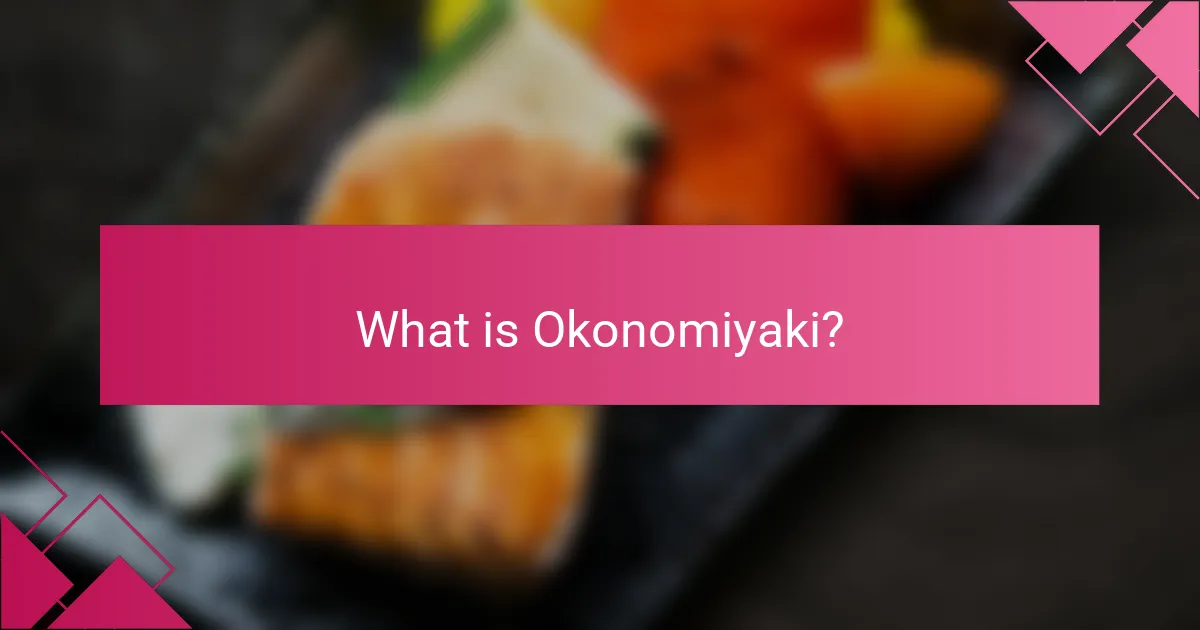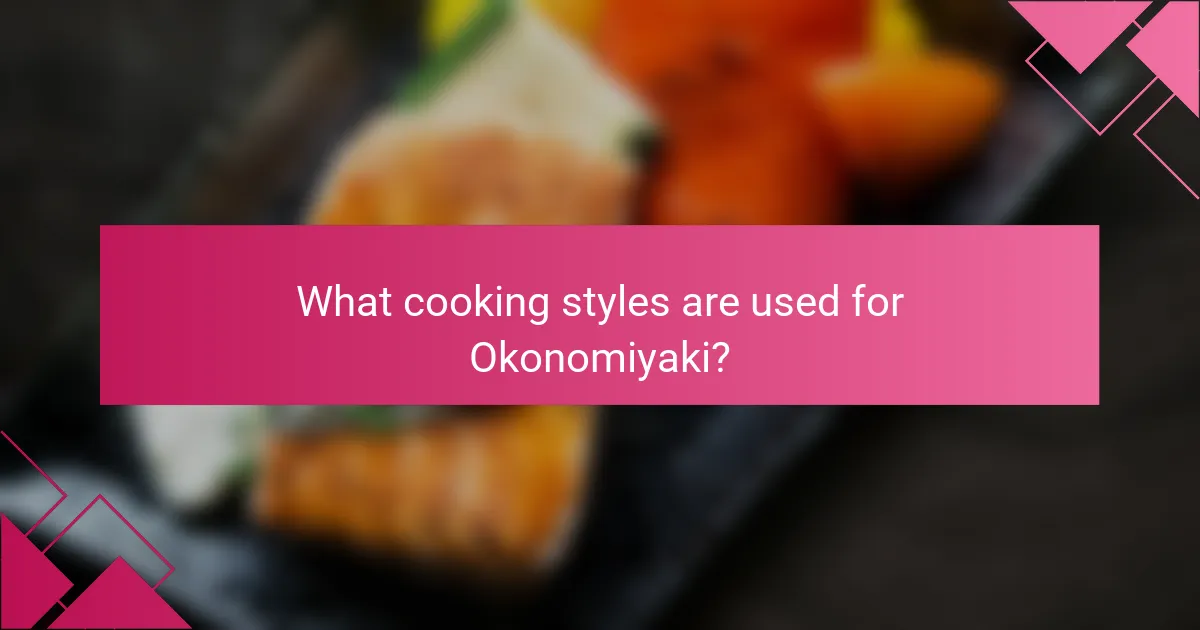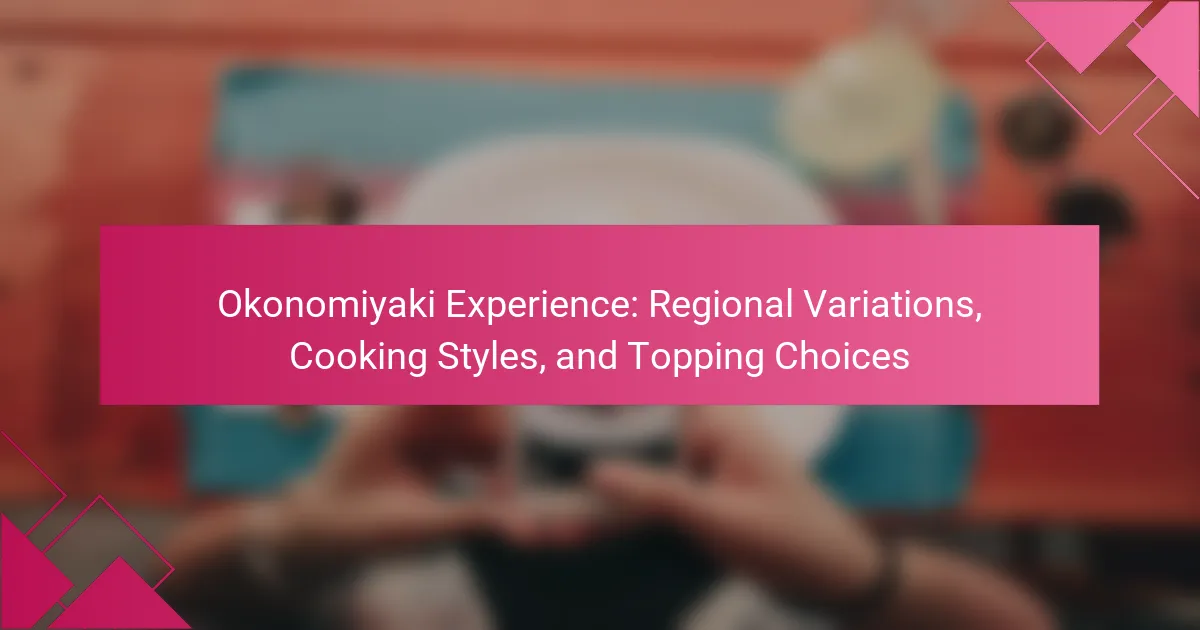
What is Okonomiyaki?
Okonomiyaki is a savory Japanese pancake made from a batter of flour, eggs, shredded cabbage, and various ingredients. It is often cooked on a griddle and can include toppings such as meat, seafood, and vegetables. The dish is highly customizable, with the name translating to “as you like it.” Okonomiyaki originates from the Kansai region, particularly Osaka, where it is a popular street food. The cooking style varies regionally, with Hiroshima-style featuring layered ingredients. It is typically served with okonomiyaki sauce, mayonnaise, and bonito flakes. The dish has a rich cultural significance in Japan, often enjoyed during festivals and gatherings.
How did Okonomiyaki originate?
Okonomiyaki originated in Japan during the Edo period. It began as a simple dish called “funoyaki,” made from flour, water, and other ingredients. The dish evolved over time, incorporating various regional ingredients and cooking styles. In the 20th century, okonomiyaki gained popularity in Osaka and Hiroshima. Each region developed its unique take on the dish. Hiroshima’s version layers ingredients, while Osaka’s mixes them together. Today, okonomiyaki is a beloved street food in Japan. Its diverse variations reflect local tastes and preferences.
What historical influences shaped Okonomiyaki?
Okonomiyaki was shaped by various historical influences, particularly during the Edo period. This period saw the rise of street food culture in Japan. The dish evolved from a simple batter of flour and water to include various ingredients. After World War II, food scarcity led to the incorporation of cabbage and other vegetables. This adaptation made Okonomiyaki more nutritious and affordable. Regional variations also emerged, influenced by local tastes and available ingredients. For example, Hiroshima-style Okonomiyaki includes noodles, reflecting the region’s culinary preferences. The combination of these historical factors contributed to the diverse forms of Okonomiyaki enjoyed today.
How has Okonomiyaki evolved over time?
Okonomiyaki has evolved significantly since its origins in the Edo period. Initially, it was a simple rice pancake called “funoyaki.” Over time, it transformed into a savory dish incorporating various ingredients. By the post-World War II era, it gained popularity in Osaka and Hiroshima, leading to regional variations. Osaka-style features a batter mixed with ingredients, while Hiroshima-style layers the ingredients separately. The introduction of mayonnaise and special sauces in the 20th century further enhanced its flavor. Today, Okonomiyaki is celebrated globally, with diverse toppings reflecting local tastes and preferences.
What are the key ingredients in Okonomiyaki?
The key ingredients in Okonomiyaki include flour, eggs, shredded cabbage, and dashi stock. These components form the base of the dish. Additional ingredients can vary based on regional styles. Common additions include green onions, meat, seafood, and cheese. Toppings often consist of mayonnaise, okonomiyaki sauce, and bonito flakes. The combination of these ingredients creates a savory pancake. Each ingredient contributes to the overall flavor and texture. The versatility of Okonomiyaki allows for numerous variations across Japan.
What role do different flours play in Okonomiyaki?
Different flours play a crucial role in the texture and flavor of Okonomiyaki. The primary flour used is all-purpose flour, which provides a balanced structure. It helps bind the ingredients together and contributes to a chewy texture. Some regions use a combination of flours, such as wheat and rice flour, to achieve a unique consistency. Rice flour can create a lighter, crispier pancake.
The use of different flours can also affect the taste. For instance, buckwheat flour may impart a nutty flavor. Variations in flour types can lead to diverse Okonomiyaki experiences across regions. For example, Hiroshima-style Okonomiyaki often includes a thicker batter, while Osaka-style is thinner. The choice of flour thus influences both the culinary outcome and regional identity of the dish.
How do the fillings and toppings vary by region?
Fillings and toppings for okonomiyaki vary significantly by region in Japan. In Hiroshima, the style includes layers of noodles and a variety of seafood. Osaka-style okonomiyaki emphasizes a batter mixed with ingredients like cabbage and pork. In the Kansai region, toppings often include mayonnaise and bonito flakes. The Kanto region favors a sweeter sauce and different vegetables. Regional preferences reflect local ingredients and culinary traditions. For instance, Hiroshima’s use of yakisoba noodles showcases its unique take on the dish. These regional differences contribute to the diverse okonomiyaki experience across Japan.
What are the different regional variations of Okonomiyaki?
Okonomiyaki has several regional variations in Japan. The two most famous styles are Hiroshima-style and Osaka-style. Hiroshima-style incorporates layers of ingredients, including noodles, and is cooked in stages. Osaka-style mixes ingredients into the batter before cooking. Other regional variations include Tokyo-style, which often features a thinner pancake, and Kansai-style, known for its rich toppings. Each variation reflects local ingredients and culinary traditions. For example, Hiroshima-style uses a unique blend of seafood and vegetables, showcasing the region’s coastal resources.
How does Hiroshima-style Okonomiyaki differ from Osaka-style?
Hiroshima-style Okonomiyaki differs from Osaka-style primarily in its layering technique. Hiroshima-style features distinct layers of ingredients, including noodles, rather than mixing them into the batter. The batter is spread thin on the grill, followed by layers of cabbage, meat, and other toppings. In contrast, Osaka-style combines all ingredients into a single batter before cooking. Hiroshima-style also often includes yakisoba or udon noodles, enhancing its texture and heartiness. This method reflects regional cooking traditions and preferences. The differences in preparation lead to unique flavors and experiences in each style.
What unique ingredients are used in regional variations?
Regional variations of okonomiyaki utilize unique ingredients that reflect local tastes and traditions. In Hiroshima, noodles are a distinctive addition, creating a layered texture. Osaka-style okonomiyaki features a batter made with yam, enhancing its fluffiness. In Nagasaki, champon noodles are often included, providing a unique twist. Other regions may incorporate local seafood, such as squid or shrimp, to enhance flavor. Some variations use specific vegetables, like perilla leaves in Kagawa. Each region’s unique ingredients contribute to the overall diversity of okonomiyaki. These variations highlight the adaptability of the dish across Japan.

What cooking styles are used for Okonomiyaki?
Okonomiyaki is primarily cooked using two styles: Hiroshima-style and Osaka-style. Hiroshima-style involves layering ingredients, including noodles, and cooking them separately before combining. This method results in a multi-layered dish with distinct textures. Osaka-style, on the other hand, mixes all ingredients into a batter before cooking on a griddle. This style yields a thicker, pancake-like consistency. Both styles are popular in Japan and showcase regional preferences in preparation.
How is Okonomiyaki prepared on a griddle?
Okonomiyaki is prepared on a griddle by mixing flour, water, eggs, and shredded cabbage to form a batter. Additional ingredients like meat, seafood, and green onions are often included. The griddle is preheated to a medium temperature. The batter is poured onto the griddle, forming a thick pancake. It is then cooked for several minutes on one side until golden brown. After flipping, it is cooked on the other side until fully set. Once cooked, Okonomiyaki is topped with okonomiyaki sauce, mayonnaise, bonito flakes, and seaweed. This cooking method allows for a crispy exterior while maintaining a soft interior.
What techniques enhance the flavor and texture of Okonomiyaki?
Incorporating dashi stock in the batter enhances the flavor of Okonomiyaki. This traditional Japanese stock adds umami depth. Using high-quality ingredients like fresh seafood and vegetables improves texture and taste. Grating yam into the batter creates a lighter, fluffier texture. Cooking on a hot griddle ensures a crispy exterior while keeping the inside moist. Layering toppings, such as bonito flakes and mayonnaise, adds complexity to each bite. Additionally, allowing the batter to rest before cooking improves the final texture. These techniques collectively elevate the overall Okonomiyaki experience.
How does the cooking method differ in restaurants versus home cooking?
Cooking methods in restaurants differ from home cooking primarily in scale and equipment. Restaurants often use commercial-grade equipment that allows for higher temperatures and faster cooking times. For example, a restaurant may use a teppanyaki grill that reaches over 500°F, while home kitchens typically have standard stovetops with lower maximum temperatures.
Additionally, restaurants often employ professional chefs trained in specific techniques, ensuring consistency and presentation. They may also use pre-prepared ingredients for efficiency, whereas home cooks typically start with raw ingredients.
Moreover, portion sizes in restaurants are larger, requiring different cooking approaches. For instance, a restaurant may prepare okonomiyaki in bulk, while home cooking focuses on individual servings.
These differences result in variations in flavor, texture, and presentation between restaurant and home-cooked okonomiyaki.
What equipment is essential for making Okonomiyaki?
A flat griddle or skillet is essential for making Okonomiyaki. This equipment allows for even cooking and proper browning. A spatula is also necessary for flipping and serving the pancake. Mixing bowls are required to combine the batter and ingredients. A whisk or fork helps to mix the batter smoothly. Additionally, a ladle is useful for pouring the batter onto the cooking surface. Finally, a squeeze bottle can be used for applying sauces and toppings. These tools ensure a successful Okonomiyaki-making experience.
What types of griddles are best for cooking Okonomiyaki?
Electric griddles and cast iron griddles are best for cooking Okonomiyaki. Electric griddles provide even heat distribution and adjustable temperature settings. This allows for consistent cooking results. Cast iron griddles retain heat well, creating a crispy exterior. They also enhance the flavor through seasoning. Both types can accommodate multiple pancakes at once. This is beneficial for serving larger groups. Griddles with a non-stick surface simplify the cooking process. They prevent sticking and make flipping easier.
How do cooking tools affect the final outcome of Okonomiyaki?
Cooking tools significantly influence the final outcome of Okonomiyaki. The type of pan used affects the heat distribution and cooking time. A cast-iron griddle retains heat better, leading to a crispy bottom. Non-stick pans reduce the risk of sticking but may not achieve the same texture. The spatula’s design impacts flipping and shaping the pancake. A wider spatula allows for easier handling of larger Okonomiyaki. Additionally, the thickness of the cooking tool can affect cooking speed. Thicker tools may require longer cooking times. Each tool’s material and design directly contribute to the texture and flavor profile of the final dish.

What are the popular topping choices for Okonomiyaki?
Popular topping choices for Okonomiyaki include bonito flakes, green onions, and mayonnaise. Bonito flakes add a savory umami flavor. Green onions provide freshness and a slight crunch. Mayonnaise is often drizzled on top for creaminess. Other common toppings are pickled ginger and seaweed flakes. Each region in Japan may have unique variations. For example, Hiroshima-style Okonomiyaki often includes noodles. These toppings enhance the overall taste and texture of the dish.
What traditional toppings are commonly used in Okonomiyaki?
Traditional toppings commonly used in Okonomiyaki include bonito flakes, mayonnaise, and green onions. Bonito flakes, or katsuobushi, are dried fish flakes that add umami flavor. Mayonnaise is often drizzled on top for creaminess. Green onions provide freshness and a mild onion flavor. Other common toppings are pickled ginger, seaweed, and a variety of meats like pork or shrimp. These toppings enhance the overall taste and texture of Okonomiyaki, making it a versatile dish.
How do toppings influence the overall flavor profile?
Toppings significantly influence the overall flavor profile of okonomiyaki. They add unique tastes and textures that enhance the dish. Common toppings include bonito flakes, mayonnaise, and green onions. Bonito flakes provide a savory umami flavor. Mayonnaise adds creaminess and tang. Green onions contribute a fresh, sharp note. Each topping interacts with the base ingredients, creating a complex flavor experience. The combination of these toppings varies by region, reflecting local preferences. For instance, some regions may emphasize seafood toppings, while others focus on meats. This regional variation further diversifies the flavor profiles of okonomiyaki.
What are some innovative toppings that have emerged?
Innovative toppings for okonomiyaki include avocado, sriracha mayo, and kimchi. Avocado adds creaminess and a fresh flavor. Sriracha mayo introduces a spicy kick that enhances the dish. Kimchi offers a tangy and fermented taste that complements the savory elements. Other emerging toppings are truffle oil and smoked salmon. Truffle oil provides a luxurious aroma and depth. Smoked salmon adds a rich, umami flavor profile. These toppings reflect evolving culinary trends and regional influences in okonomiyaki preparation.
How do dietary preferences affect topping choices?
Dietary preferences significantly influence topping choices for okonomiyaki. Vegetarians often select plant-based toppings like cabbage and mushrooms. Vegans may opt for similar choices, avoiding eggs and seafood. Gluten-free individuals might choose rice flour-based okonomiyaki and toppings without gluten. Meat lovers typically prefer options such as pork or beef. Health-conscious consumers might favor lighter toppings like green onions and seaweed. According to a study published in the Journal of Culinary Science & Technology, dietary restrictions directly impact ingredient selection in regional dishes. This shows that preferences shape the overall okonomiyaki experience.
What vegetarian or vegan options are available for Okonomiyaki?
Vegetarian and vegan options for Okonomiyaki typically include a variety of vegetables and plant-based ingredients. Common ingredients are cabbage, green onions, carrots, and mushrooms. Vegan versions often replace traditional egg with a mixture of flour and water or plant-based alternatives. Toppings can include vegan mayonnaise, seaweed, and bonito flakes made from mushrooms. Some recipes use tofu or tempeh for added protein. These adaptations ensure that the dish remains flavorful while catering to vegetarian and vegan diets.
How can gluten-free diets be accommodated in Okonomiyaki preparation?
Gluten-free diets can be accommodated in Okonomiyaki preparation by using alternative flours. Common substitutes include rice flour and chickpea flour. These flours provide a similar texture without gluten. Additionally, ensure that all other ingredients, such as sauces and toppings, are gluten-free. For example, use gluten-free soy sauce instead of regular soy sauce. Cross-contamination should also be avoided by using separate cooking utensils and surfaces. This approach maintains the dish’s authenticity while making it suitable for gluten-free diets.
What tips can enhance your Okonomiyaki experience?
To enhance your Okonomiyaki experience, focus on using fresh ingredients. Fresh cabbage and seafood improve flavor and texture. Experiment with regional variations, as each area in Japan offers unique twists. For instance, Hiroshima-style includes layers of noodles. Personalize toppings according to your taste. Common options include bonito flakes, mayonnaise, and pickled ginger. Cooking your Okonomiyaki on a hot griddle ensures a crispy exterior. Pair it with a suitable beverage; traditional Japanese drinks complement the dish well. Engaging with local dining customs can also enrich your experience.
How can you perfect the cooking technique at home?
To perfect the cooking technique at home, practice is essential. Focus on mastering the balance of ingredients. Use fresh, high-quality components for better flavor. Control the cooking temperature carefully to avoid burning. Experiment with different cooking styles to find your preference. Observe how regional variations impact texture and taste. Consistency in technique will improve results over time. Document your methods to refine your approach. Regularly seek feedback from others to enhance your skills.
What are common mistakes to avoid when making Okonomiyaki?
Common mistakes to avoid when making Okonomiyaki include not using the right flour. Using all-purpose flour instead of specialized Okonomiyaki flour can affect texture. Another mistake is overmixing the batter. This can lead to a tough pancake rather than a fluffy one. Failing to let the batter rest is also problematic. Resting allows the flour to hydrate properly, enhancing the final product.
Additionally, using too much or too little cabbage can disrupt the balance of flavors. The cabbage should be finely chopped and proportionate to the batter. Cooking at the wrong temperature can also ruin Okonomiyaki. High heat can burn the outside while leaving the inside raw. Lastly, neglecting to use adequate oil on the cooking surface can cause sticking. Proper oiling is essential for achieving a crispy exterior.
Okonomiyaki is a savory Japanese pancake made from flour, eggs, shredded cabbage, and various ingredients, often cooked on a griddle. The article explores the origins of Okonomiyaki, its evolution through history, and the key ingredients that define it. It highlights the distinct regional variations, such as Hiroshima-style and Osaka-style, along with the unique cooking techniques and essential equipment used in preparation. Additionally, the article discusses popular toppings, dietary adaptations, and tips for enhancing the Okonomiyaki experience, providing a comprehensive overview of this beloved dish.
